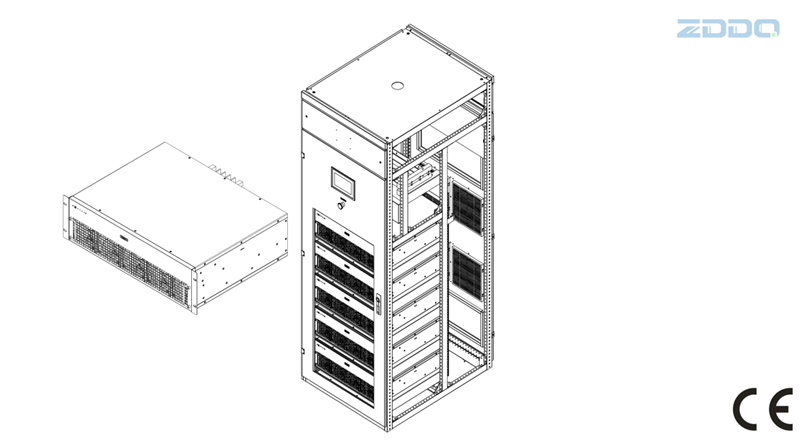In a normal power system, electrical equipment with linear impedance change characteristics will not affect the power supply with a frequency of 50Hz and a standard sinusoidal waveform when it is working. However, with the development of power electronics technology, there are more and more electrical equipment with nonlinear impedance characteristics (nonlinear loads). When these nonlinear loads are working, they will cause the power supply frequency and waveform of the power system to be distorted, from which sinusoidal waveforms of different frequencies can be decomposed. The decomposed non-50Hz AC sine waves are collectively called harmonics. Among them, the harmonic with a frequency of three times 50Hz, that is, 150Hz, is called the 3rd harmonic; the harmonic with a frequency of five times 50Hz, that is, 250Hz, is called the 5th harmonic; the harmonic with a frequency of seven times 50Hz, that is, 350Hz, is called the 7th harmonic.
2. What are the hazards of harmonics generated by lights?
LED energy-saving lamps, LED display screens, chargers, heaters, inverters, sterilizers, PC terminals and other nonlinear loads that use single-phase diode rectification will generate relatively serious odd harmonic currents when in operation. The third harmonic is the largest and is the main harmonic component. The fifth, seventh, and eleventh harmonics are also significantly higher. However, the third harmonic current cannot be vector-offset on the neutral line like the fundamental wave and the fifth, seventh, and eleventh harmonic currents of other frequencies. Instead, it is completely superimposed on the neutral line at a 360-degree vector angle, resulting in the third harmonic current on the neutral line being about three times that on the phase line. Therefore, when the third harmonic current content generated by the single-phase rectifier load reaches more than 35%, the neutral line current will abnormally increase and exceed the phase line current.
In many cases, the neutral current abnormally increases to about 2 times the phase current, causing great harm to the low-voltage distribution system, mainly including four aspects:
A. Neutral overcurrent: causing the cable to heat up, age and break, burning electrical equipment, and inducing fire hazards that are difficult to prevent and control;
B. Abnormal tripping of distribution protection: even if the load on the line does not reach the distribution design value, the zero-sequence protection tripping will occur;
C. Transformer overheating: a large amount of neutral harmonic current flows back to the transformer, causing the transformer to heat up and increase noise;
D. Power waste: The third harmonic current in the distribution system will directly increase the power consumption of the load equipment and the power supply equipment.
3. Why is the third harmonic so large?
In a normal three-phase four-wire distribution system, assuming that the three-phase load is balanced, the current in the neutral line should be very small. However, the advertising light boxes around a building are illuminated by fluorescent lamps with electronic ballasts; the load of the three-phase line is balanced, and the current of each phase is about 60A, but the neutral current reaches 90A. Why is this?
Answer: This is caused by the rectifier circuit.
When the current waveform of the phase line is a sine wave, if they differ by 120 degrees and have the same amplitude, the result of vector superposition on the neutral line is a sum of 0; but if the current on the phase line is pulsed and differs by 120 degrees, they will be superimposed on the neutral line; the pulse current on the neutral line is staggered and cannot be offset; count the number of pulse currents on the neutral line, there are three in one cycle, so the current on the neutral line is the sum of the currents of each phase line.
Nowadays, most electrical loads are rectifier circuit loads, so even if the three-phase load is balanced, there will be a large current on the neutral line. There are two main reasons for the harm of excessive neutral line current:
A. The cross-sectional area of the neutral line is not larger than that of the phase line, and the current exceeding the phase line will inevitably cause the neutral line to overheat;
B. There is no fuse on the neutral line, and it cannot be automatically disconnected under overcurrent conditions like the phase line.
4. How to control the three harmonics?
The reason why the third harmonic current is so harmful is that the superposition of the third harmonic current on the neutral line will cause the neutral line current to be too large, thus causing a fire hazard. Nowadays, most single-phase loads are devices with rectifiers as input circuits, ranging from mobile phone chargers to power drive devices such as inverters. The problem of third harmonics quickly emerges. In recent years, many shopping malls have store project acceptance index values for zero-line current values, so zero-line current management is imperative. Installing a low-voltage active power filter device ZD-APF on the busbar of the distribution cabinet is an ideal way to solve this kind of problem. The device injects harmonic currents of opposite phases into the phase line based on the harmonic current detected on the phase line to eliminate the harmonic current on the busbar. It should be noted that the function of the device is to ensure that the upstream of the filter meets the harmonic requirements. Therefore, a reasonable installation location should be selected during installation to avoid harm caused by residual harmonics downstream of the filter.

